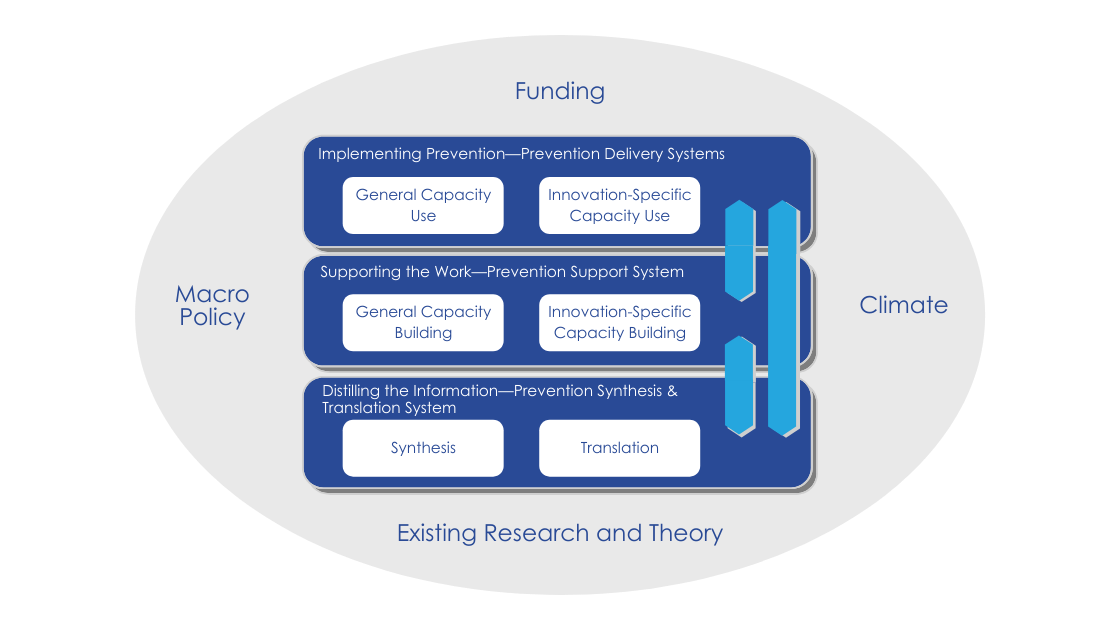By Joanie Sims-Gould, Thea Franke & Heather McKay
To implement comprehensive, evidence-based programs at scale truly ‘takes a village.’ So often, evidence-based interventions are not effectively implemented or sustained, as community organizations receive very little support or ongoing training during the implementation process.

The central support team is highlighted in the centre of this model (pictured above). It is the engine that churns away in the background— to move implementation of evidence-based interventions along the track toward scale-up. The central support unit works in partnership with community organizations to train, support, implement, scale-up, monitor, adapt and evaluate community-based programs to ensure successful implementation.
However, the role of the central support team is seldom discussed in the literature. As a result, it is not well understood.
Therefore, we conducted a study to examine the role that central support units play in building capacity in and guiding the Community-Based Seniors’ Service (CBSS) sector to deliver evidence-based interventions effectively.
We recently published our findings in a paper entitled: “How central support built capacity to deliver a health‐promoting intervention for older adults in Canada,” published in Health and Social Care in the Community.
The central support team worked with 8 CBSS organizations to implement 22 Choose to Move programmes that served 322 older adults. Choose to Move is a choice-based intervention that promotes physical activity and social connectedness through a group-based program. In an earlier study, we demonstrated that Choose to Move provided much-needed social connections and reduces feelings of loneliness amongst older adults in the community.
We conducted in-depth interviews with 23 Choose to Move program delivery partners and a focus group with those who comprised the central support team. We aimed to really dig in and identify specific elements within central support that were deemed essential to implement Choose to Move effectively.
Here’s what we are learning:
- A champion among the central support team who is aware of the context where delivery partners implement Choose to Move is essential.
- Ongoing, interactive assistance is key throughout what we call ‘the life course of the intervention.’ The central support team’s vital role is to guide, answer questions and clarify program materials over the longer term—a more effective approach than one-time pre-program training.
Never before have CBSS organizations been such an important ‘lifeline’ to meet the needs of older people. Over the past two years in British Columbia, organizations have stepped up, yet again, to support older people in extraordinary ways (e.g., during COVID-19, heat domes, forest fires and floods, to name a few). These services are layered on top of the abundance of work organizations already do to meet older people’s physical and social needs.
Our Active Aging Research Team has been fortunate to work with exceptional partners in the CBSS sector. We delivered Choose to Move across British Columbia with their support and collaboration over the past eight years. Our team provides ‘central support’ to these organizations—the training, information and resources, technical support and inter-organizational networking that enables them to build capacity to effectively deliver Choose to Move to reach the older adults they serve.
Working with these organizations, we have learned that many factors drive successful implementation of community-based programs. The mutual support that those in the CBSS sector and the central support team provide is essential to meet the health promotion needs of older people.
Read the full article here!
Sims-Gould J, McKay HA, Franke T. How central support built capacity to deliver a health-promoting intervention for older adults in Canada. Health Soc Care Community. 2022 Feb 13. doi: 10.1111/hsc.13751. Epub ahead of print. PMID: 35156247.

